2003 Oldsmobile Alero child lock
[x] Cancel search: child lockPage 2 of 354

The 2003 Oldsmobile Alero Owner Manual a
Seats and Restraint Systems ........................... 1-1
Front Seats
............................................... 1-2
Rear Seats
............................................... 1-8
Safety Belts
.............................................. 1-9
Child Restraints
....................................... 1-32
Supplemental Restraint System (SRS)
...................................... 1-53
Restraint System Check
............................ 1-60
Keys
........................................................ 2-2
Doors and Locks
....................................... 2-7
Windows
................................................. 2-1 4
Theft-Deterrent Systems ............................ 2-1 6
Starting and Operating Your Vehicle
........... 2-17
Mirrors
.................................................... 2-32
Siorage Areas
......................................... 2-34
Sunroof .................................................. 2-35
Instrument Panel Overview
.......................... 3-4
Climate Controls
...................................... 3-1 9
.w .arning Lights, Gages and indicators ......... 3-23
Audio System(s) ....................................... 3-38
Features and Controls
..................................... 2-1
Instrument Panel
............................................. 3-1 Driving Your Vehicle
....................................... 4-1
Your Driving, the Road, and Your Vehicle
..... 4-2
Towing
................................................... 4-31
Service
..................................................... 5-3
Fuel ......................................................... 5-5
Checking Things Under
the
Hood ............................................... 5-9
Headlamp Aiming
..................................... 5-47
Bulb Replacement .................................... 5-49
Windshield Wiper Blade Replacement
......... 5-52
Tires
...................................................... 5-53
Appearance Care
..................................... 5-72
Vehicle Identification
................................. 5-80
Electrical System
...................................... 5-81
Zapai;iiit=s at-tii ~J~LIIIL~LIUI I> 5-w~
Normal Maintenance Replacement Parts ...... 5-88
Maintenance Schedule ........................... ... 6-1
Maintenance Schedule
................................ 6-2
Customer Assistance Information
.................... 7-1
Customer
Assistance iniorrnation .................. 7-2
Index ................................................................. 1
Service
and Appearance Care
.......................... 5-1
n.- - -:I: - -1: - .- - .....................
Page 6 of 354

These are some examples of vehicle symbols you may find on your vehicle:
POSSIBLE A
CAUTION
INJURY
PROTECT EYES BY
SHIELDING
CAUSTIC
BATTERY
ACID COULD CAUSE
BURNS
AVO1 D
1 SPARKS OR
1 FLAMES
1 BATTERY LATCH BOTH LAP AND
SHOULDER BELTS TO
PROTECT OCCUPANT
48: @
DO NOT TWIST SAFETY
BELT WHEN ATTACHING
FASTEN SEAT
BELTS
MOVE SEAT FULLY
\!$
REARWARD+ /z
SECURE
CHILD SEAT
PULL BELT
COMPLETELY
THEN SECURE CHILD SEAT
I
1
DO NOT INSTALL
A REAR-FACING
CHILD RESTRAINT IN THIS SEATING
POSITION
DO NOT INSTALL A
'ORWARD-FACING CHILD RESTRAINT
IN THIS SEATING
POSITION
--,.-. ,.,.,, a uvun Luun
UNLOCK JGHTING
- MASTER SWITCH B- / ,
SIGNALS @+
TURN
PARKING
pf
LAMPS
DAYTIME
**a
RUNNING y.:
LAMPS 0
ENGINE
COOLANT TEMP
CHARGING
I-]
BATTERY SYSTEM
COOLANT
d
ENGINE OIL
PRESSURE
Wb
ENGINE
COOLANT FAN
OWNERS MANUAL
SERVICE
SFRVICF
MANUAL
V
Page 30 of 354

The best way to protect the fetus is to protect the
mother. When a safety belt is worn properly, it’s more
likely that the fetus won’t be hurt
in a crash. For
pregnant women, as for anyone, the key to making
safety belts effective is wearing them properly.
Right Front Passenger Position
To learn how to wear the right front passenger’s safety
belt properly, see
Driver Position on page 1-75.
The right front passenger’s safety belt works the same
way as the driver’s safety belt
- except for one
thing.
If you ever pull the shoulder portion of the belt out
all the way, you will engage the child restraint locking
feature.
if this happens, just iet the beit go back aii
the way and start again.
Rear Seat Passengers
It’s very important for rear seat passengers to buckle
up! Accident statistics show that unbelted people in the
rear seat are hurt more often in crashes than those
who are wearing safety belts.
Rear passengers who aren’t safety belted can be
thrown out of the vehicle in a crash. And they can strike
others in the vehicle who are wearing safety belts.
Rear Seat Outside Passenger Positions
1-23
Page 76 of 354
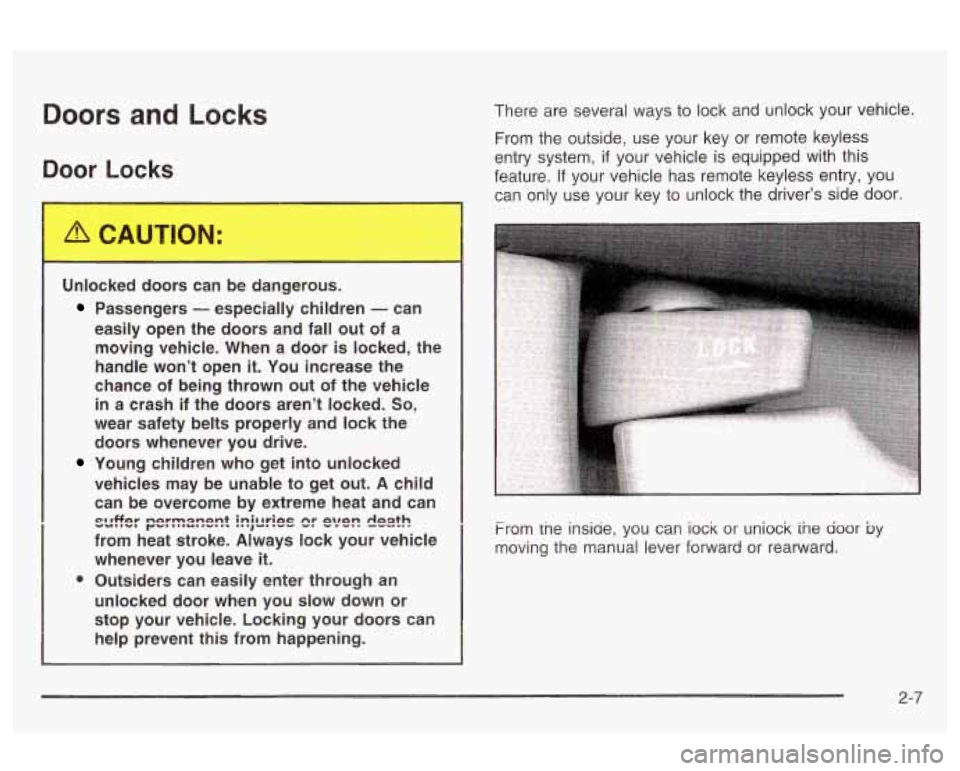
Doors and Locks
Door Lcnks
~~ -
Unlocked doors can be dangerous.
Passengers - especially children - can
easily open
the doors and fall out of a
moving vehicle. When a door
is locked, the
handle won’t open
it. You increase the
chance of being thrown out of the vehicle
in a crash if the doors aren’t locked. So,
wear safety belts properly and lock the
doors whenever you drive.
vehicles may be unable to get out.
A child
can be overcome by extreme heat and can
from heat stroke. Always lock your vehicle
whenever you leave
it.
unlocked door when you slow down or
stop your vehicle. Locking your doors can
help prevent
this from happening.
Young children who get into unlocked
szcer per!?laK!n! i!?;wies cr e‘!e!? del!!?
0 Outsiders can easily enter through an There are
several ways to lock and unlock your vehicle.
From the outside, use your key or remote keyless
entry system, if your vehicle
is equipped with this
feature.
If your vehicle has remote keyless entry, you
can only use your key to unlock the driver’s side door.
From tne insiae, you can iock or uniock
ine door by
moving the manual lever forward or rearward.
2-7
Page 79 of 354
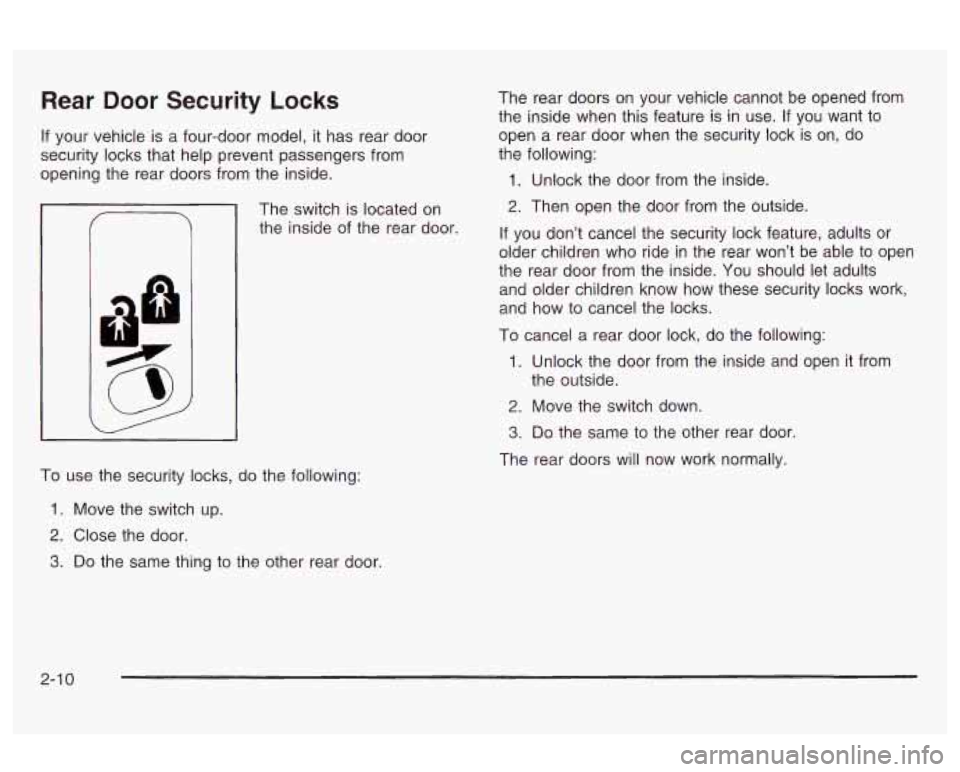
Rear Door Security Locks
If your vehicle is a four-door model, it has rear door
security locks that help prevent passengers from
opening the rear doors from the inside.
The switch is located on
the inside of the rear door. The
rear doors on your vehicle cannot be opened from
the inside when this feature
is in use. If you want to
open a rear door when the security lock is on, do
the following:
1. Unlock the door from the inside.
2. Then open the door from the outside.
If you don’t cancel the security lock feature, adults or
older children who ride in the rear won’t be able
to open
the rear door from the inside. You should let adults
and older children know how these security locks work,
and how to cancel the locks.
To cancel a rear door lock,
do the following:
1. Unlock the door from the inside and open it from
2. Move the switch down.
the
outside.
3. Do the same to the other rear door.
The rear doors will now work normally.
To use the security locks, do the following:
1. Move the switch up.
2. Close the door.
3. Do the same thing to the other rear door.
2-1 0
Page 184 of 354
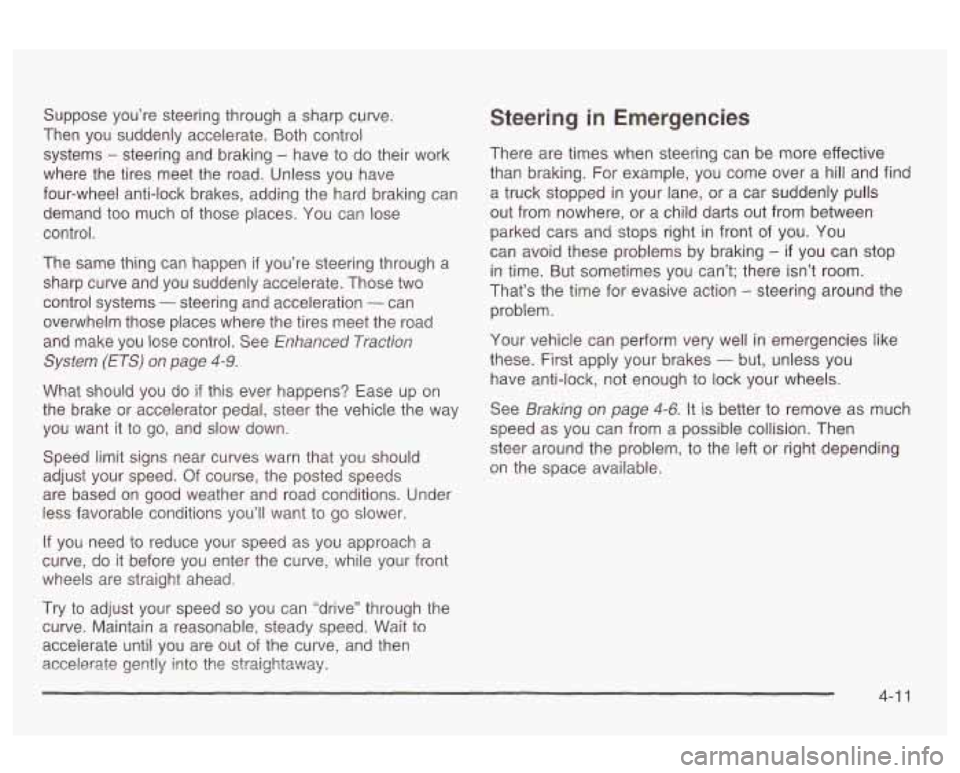
Suppose you’re steering through a sharp curve.
Then you suddenly accelerate. Both control
systems
- steering and braking - have to do their work
where the tires meet the road. Unless you have
four-wheel anti-lock brakes, adding the hard braking can
demand too much of those places. You can lose
control.
The same thing can happen
if you’re steering through a
sharp curve and you suddenly accelerate. Those two
control systems
- steering and acceleration - can
overwhelm those places where the tires meet the road
and make you lose control. See
Enhanced Traction
System (ETS) on page 4-9.
What should you do if this ever happens? Ease up on
the brake or accelerator pedal, steer the vehicle the way
you want it to go, and slow down.
Speed limit signs near curves warn that you should
adjust your speed. Of course, the posted speeds
are based on good weather and road conditions. Under
less favorable conditions you’ll want to go slower.
If you need to reduce your speed as you approach a
curve, do it before you enter the curve, while your front
wheels are straight ahead.
Try to adjust your speed so you can “drive” through the
curve. Maintain a reasonable, steady speed. Wait to
accelerate until you are out of the curve, and then
accelerate gently into the straightaway.
Steering in Emergencies
There are times when steering can be more effective
than braking. For example, you come over a
hill and find
a truck stopped in your lane, or a car suddenly pulls
out from nowhere, or a child darts out from between
parked cars and stops right
in front of you. You
can avoid these problems by braking
- if you can stop
in time. But sometimes you can’t; there isn’t room.
That’s the time for evasive action
- steering around the
problem.
Your vehicle can perform very well in emergencies like
these. First apply your brakes
- but, unless you
have anti-lock, not enough to lock your wheels.
See
Braking on page 4-6. It is better to remove as much
speed as you can from a possible collision. Then
steer around the problem, to the left or right depending
on the space available.
Page 339 of 354
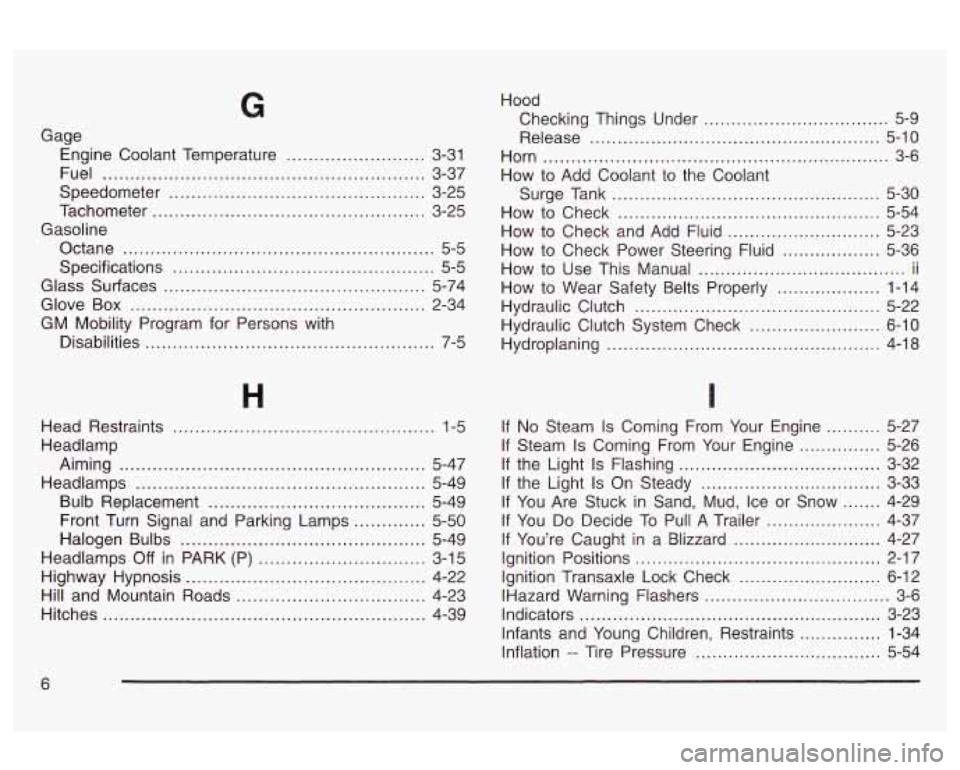
G
Gage Engine Coolant Temperature
......................... 3-31
Fuel
.......................................................... 3-37
Speedometer
.............................................. 3-25
Tachometer
................................................. 3-25
Octane
........................................................ 5-5
Specifications ............................................... 5-5
Glass Surfaces
............................................... 5-74
Glove Box
..................................................... 2-34
GM Mobility Program for Persons with
Disabilities
.................................................... 7-5
Gasoline
H
Head Restraints ............................................... 1-5
Headlamp
Aiming
....................................................... 5-47
Headlamps
.................................................... 5-49
Bulb Replacement
....................................... 5-49
Front Turn Signal and Parking Lamps
............. 5-50
Halogen Bulbs
............................................ 5-49
Headlamps
Off in PARK (P) .............................. 3-15
Highway Hypnosis
........................................... 4-22
Hill and Mountain Roads
.................................. 4-23
Hitches
.......................................................... 4-39 Hood
Checking Things Under
.............................. 5-9
Release
..................................................... 5-10
Horn
........................................................... 3-6
How to Add Coolant to the Coolant
Surge Tank
............................. ............ 5-30
How to Check
................................................ 5-54
How to Check and Add Fluid
............................ 5-23
How to Check Power Steering Fluid
.................. 5-36
How to Use This Manual
...................................... ii
How to Wear Safety Belts Properly ................... 1-14
Hydraulic Clutch
............................................. 5-22
Hydraulic Clutch System Check
........................ 6-10
Hydroplaning
.................................................. 4-18
If
No Steam Is Coming From Your Engine .......... 5-27
If Steam
Is Coming From Your Engine ............... 5-26
If the Light
Is Flashing ..................................... 3-32
If the Light
Is On Steady ................................. 3-33
If You Are Stuck in Sand, Mud, Ice or Snow
....... 4-29
If You Do Decide
To Pull A Trailer ..................... 4-37
If You’re Caught in a Blizzard
........................... 4-27
Ignition Positions
............................................. 2-17
Ignition Transaxle Lock Check
.......................... 6-12
IHazard Warning Flashers
.................................. 3-6
Indicators
....................................................... 3-23
Infants and Young Children, Restraints
............... 1-34
Inflation
-- Tire Pressure .................................. 5-54
Page 340 of 354
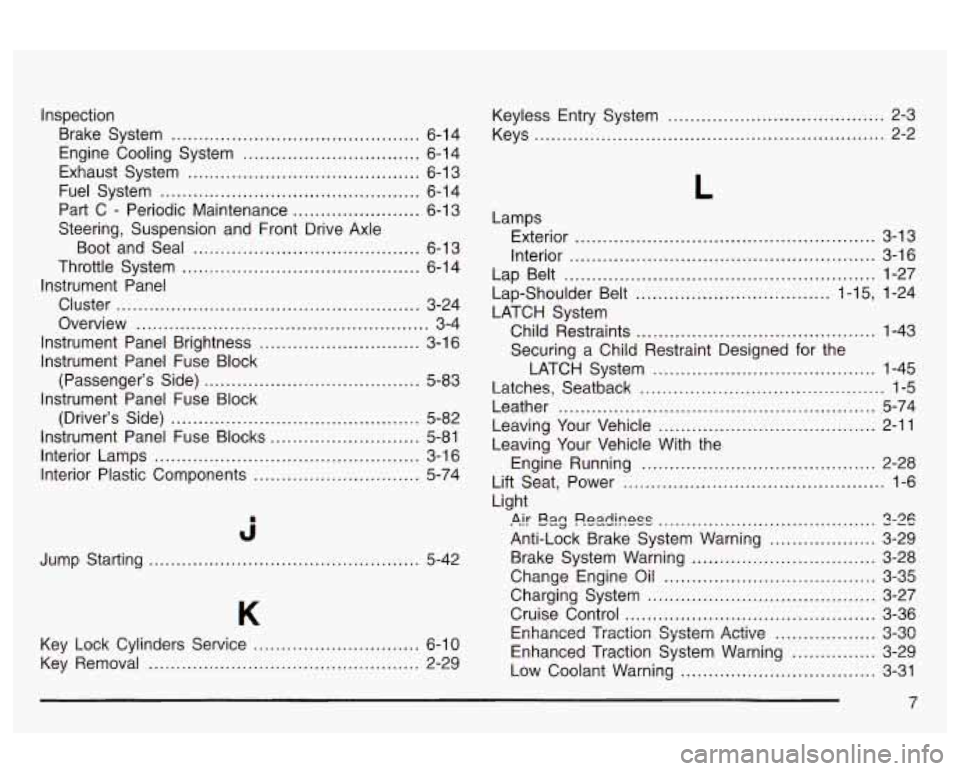
Inspection Brake System
............................................. 6-14
Engine Cooling System
................................ 6-14
Fuel System
............................................... 6-14
Part C
. Periodic Maintenance ....................... 6-13
Steering. Suspension and Front Drive Axle
Boot and Seal
......................................... 6-1 3
Throttle System
.................................... 6-1 4
Cluster
....................................................... 3-24
Overview
..................................................... 3-4
Instrument Panel Brightness
............................. 3-1 6
Instrument Panel Fuse Block
(Passenger's Side)
....................................... 5-83
instrument Panel Fuse Block
(Driver's Side)
............................................. 5-82
Instrument Panel Fuse Blocks
........................... 5-81
Exhaust System
.......................................... 6-13
Instrument Panel
Interior Lamps
................................................ 3-16
Interior Plastic Components
.............................. 5-74
J
Jump Starting ................................................. 5-42
Key Lock Cylinders Service
.............................. 6-10
Key Removal
................................................. 2-29 Keyless
Entry System
....................................... 2-3
Keys
............................................................... 2-2
L
Lamps
Exterior
............ .... ........ 3-13
Interior
....................................................... 3-16
Lap Belt
........................................................ 1-27
Lap-Shoulder Belt
................................... 1.15. 1-24
LATCH System Child Restraints
........................................... 1-43
Securing a Child Restraint Designed for the
LATCH System
........................................ 1-45
Latches,
Seatback ............................................ 1-5
Leather ......................................................... 5-74
Leaving Your Vehicle
....................................... 2-11
Leaving Your Vehicle With the
Engine Running
.......................................... 2-28
Lift Seat, Power
....................... ......... 1-6
Light
................................... 3-26
Anti-Lock Brake System Warning ................... 3-29
Brake System Warning
................................. 3-28
Change Engine Oil
...................................... 3-35
Charging System
......................................... 3-27
Cruise Control
............................................. 3-36
Enhanced Traction System Warning
............... 3-29
Low Coolant Warning
................................... 3-31
. A-ir -"a Ran Rnadinncc .V UU ... YYY
LI c+,,,, I talIbGd T;actior; System Active J-JO QQ ..................
7